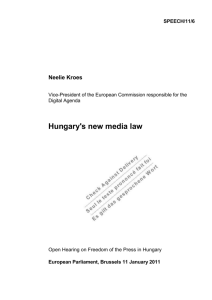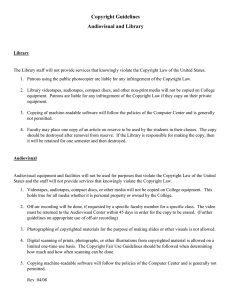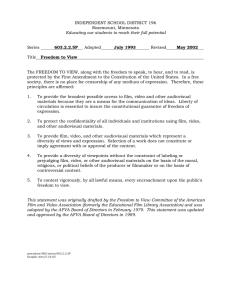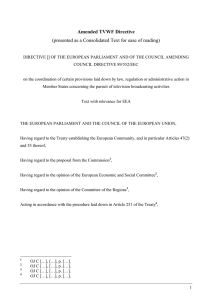EBU/ITU Meeting of High-Level Experts on
advertisement
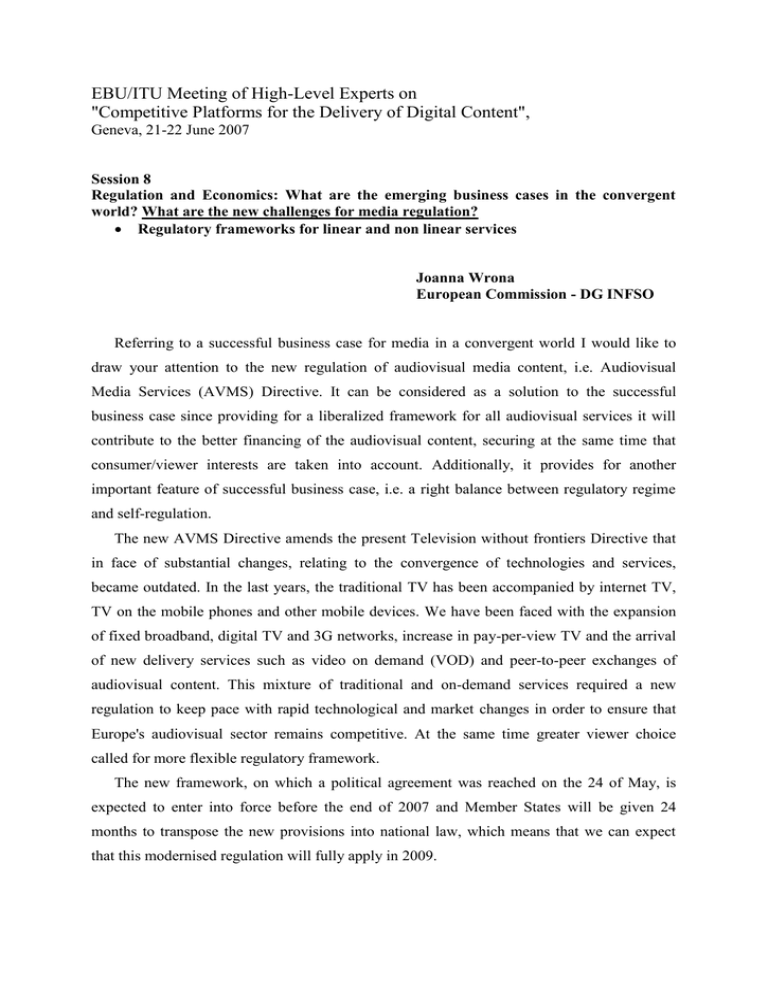
EBU/ITU Meeting of High-Level Experts on "Competitive Platforms for the Delivery of Digital Content", Geneva, 21-22 June 2007 Session 8 Regulation and Economics: What are the emerging business cases in the convergent world? What are the new challenges for media regulation? Regulatory frameworks for linear and non linear services Joanna Wrona European Commission - DG INFSO Referring to a successful business case for media in a convergent world I would like to draw your attention to the new regulation of audiovisual media content, i.e. Audiovisual Media Services (AVMS) Directive. It can be considered as a solution to the successful business case since providing for a liberalized framework for all audiovisual services it will contribute to the better financing of the audiovisual content, securing at the same time that consumer/viewer interests are taken into account. Additionally, it provides for another important feature of successful business case, i.e. a right balance between regulatory regime and self-regulation. The new AVMS Directive amends the present Television without frontiers Directive that in face of substantial changes, relating to the convergence of technologies and services, became outdated. In the last years, the traditional TV has been accompanied by internet TV, TV on the mobile phones and other mobile devices. We have been faced with the expansion of fixed broadband, digital TV and 3G networks, increase in pay-per-view TV and the arrival of new delivery services such as video on demand (VOD) and peer-to-peer exchanges of audiovisual content. This mixture of traditional and on-demand services required a new regulation to keep pace with rapid technological and market changes in order to ensure that Europe's audiovisual sector remains competitive. At the same time greater viewer choice called for more flexible regulatory framework. The new framework, on which a political agreement was reached on the 24 of May, is expected to enter into force before the end of 2007 and Member States will be given 24 months to transpose the new provisions into national law, which means that we can expect that this modernised regulation will fully apply in 2009. The regulation establishes a single market for all audiovisual services since it covers for the first time not just linear but also on-demand services, though the latter are subject to lighter harmonization. It is so because there would be no justification for regulating audiovisual content supplied at the viewer's request beyond safeguarding essential public interests such as protecting minors, encouraging cultural diversity,, preventing incitement to hatred or basic consumer protection rules. Setting a Community benchmark for the regulation of these key general interests is meant to discourage Member States from regulating further than the provisions of the Directive require. The new regulation creates a legal security both for businesses and citizens. As regards businesses three main features should be noted. Firstly, the Directive provides for a comprehensive regulatory framework that reduces the regulatory burden and covers all audiovisual media services.This means that for the first time – no matter how distributed (including over electronic networks) – these audiovisual media services would have to comply with a set of minimum rules harmonised at the European level with regard to the protection of minors and human dignity, but also in view of qualitative rules concerning advertising. Secondly, the Directive is based on the country of origin principle that has already helped Europe's broadcasting industry to flourish since 1989 and now it will also apply, with the minimum harmonization, to no-linear services. It will contribute to creating a level playing field for all companies that offer on-demand audiovisual media services, irrespective of the technology used to deliver their services. Finally, less detailed and modernised rules on advertising will allow for their flexible application which will ensure better financing of audiovisual content. The new Directive relaxes rules on inserting advertising in TV programmes and is open to new forms of advertising. Instead of being compelled - as is now the case - to allow twenty minutes time between each advertising break, broadcasters will be able to choose the most appropriate moment to insert advertising during programmes. Nonetheless, films made for television (excluding series, serials and documentaries) cinematographic films, children programmes and news remain protected and may only be interrupted once per each period of 30 minutes time. The rule that advertising is restricted to 12 minutes in any given hour also remains in place. However, it is a legal framework for product placement that has been considered as one of the biggest successes of the new Directive since it will ensure a better information of viewers while allowing new income for the audiovisual industry. At the same time it will help to boost Europe's creativity and reinforce cultural diversity. This practice is not addressed as such by the current Directive and only prohibited in as far as it can, under certain circumstances, be considered to be surreptitious advertising. Product placement is, nonetheless already authorised, under certain conditions, by some Member States and is widely practiced all over Europe in independently produced works and feature films without any EU level protection for consumers. The new regulation introduces clear rules on product placement, obliging broadcasters to inform consumers when it takes place, thus providing for an adequate level of consumer protection. The Directive also provides for other consumer/citizen oriented provisions, such as: clear identification of media service provider; a new right to access to extracts of important events for general new purposes, which supplements the right of access on free to air TV to events of major importance; the prohibition of incitement to hatred for all audiovisual media services; the encouragement of improved access to audiovisual media services for people with visual or hearing disability; the respect by all audiovisual media services (also on-demand) of a set of qualitative rules on commercial communications, notably with regard to respect for human dignity and the protection of children; the setting up of codes of conduct on commercial communications for unhealthy foodstuffs in and around children's programmes. The new regulatory framework will play a significant role for media regulation and due to its flexibility will not hinder the activities that the media sector has to undertake in order to accommodate technological and market developments, as well as changing viewing habits resulting from convergence. It is also expected to ensure a right balance between the level of public regulation and market driven solutions by requiring from Member states and the Commission to encourage co-and self-regulatory regimes at national level in the fields coordinated by the Directive. This combination of the liberal public regulation and business based models of regulation should constitute a very positive regulatory environment for media, provided that it is effectively enforced.

